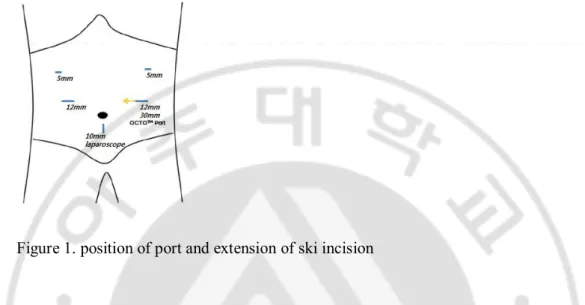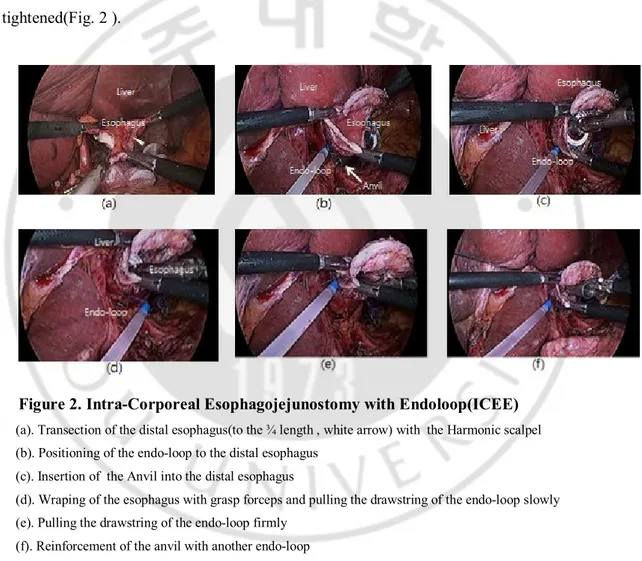저작자표시-비영리-변경금지 2.0 대한민국 이용자는 아래의 조건을 따르는 경우에 한하여 자유롭게 l 이 저작물을 복제, 배포, 전송, 전시, 공연 및 방송할 수 있습니다. 다음과 같은 조건을 따라야 합니다: l 귀하는, 이 저작물의 재이용이나 배포의 경우, 이 저작물에 적용된 이용허락조건 을 명확하게 나타내어야 합니다. l 저작권자로부터 별도의 허가를 받으면 이러한 조건들은 적용되지 않습니다. 저작권법에 따른 이용자의 권리는 위의 내용에 의하여 영향을 받지 않습니다. 이것은 이용허락규약(Legal Code)을 이해하기 쉽게 요약한 것입니다. Disclaimer 저작자표시. 귀하는 원저작자를 표시하여야 합니다. 비영리. 귀하는 이 저작물을 영리 목적으로 이용할 수 없습니다. 변경금지. 귀하는 이 저작물을 개작, 변형 또는 가공할 수 없습니다.
1
Novel reconstruction method after laparoscopic
total gastrectomy
: Intra-Corporeal Esophagojejunostomy with
Endoloop(ICEE)
by
Cheul Su Byun
Major in Medicine
Department of Medical Sciences
The Graduate School, Ajou University
2
Novel reconstruction method after laparoscopic
total gastrectomy
: Intra-Corporeal Esophagojejunostomy with
Endoloop(ICEE
by
Cheul Su Byun
A Dissertation Submitted to The Graduate School of
Ajou University in Partial Fulfillment of the Requirements
for the Degree of
Master of Medicine
Supervised by
Sang-Uk Han, M.D., Ph.D.
Major in Medicine
Department of Medical Sciences
The Graduate School, Ajou University
3
This certifies that the dissertation
ofCheul Su Byun is approved.
SUPERVISORY COMMITTEE
GiMyung Lee
Young Bae Kim
Sang Uk Han
The Graduate School, Ajou University
November, 19rd, 2013
4
-ASTRACT-
Novel reconstruction method afterlaparoscopic total gastrectomy
: Intra-Corporeal Esophagojejunostomywith Endoloop(ICEE)
Background. Although laparoscopic distal gastrectomy has been used widely for treatment for gastric cancer, laparoscopic total gastrectomy(LTG) is still uncommon. One of the reasons is the technical difficulty of performing the esophagojejunal anastomosis, especially anvil-insertion. Various reconstruction methods have been reported, but optimal method has not been established. Based upon our experience of laparoscopic total gastrectomy, we developed very simple and safe esophagojejunal anastomosis method and we named it as Intra-Corporeal Esophagojejunostomy with Endoloop(ICEE). In this study , we compared the short outcomes of LTG reconstructed by conventional purse-string suture and by ICEE.
Methods. From January 2009 to December 2012 , LTG with intracorporeal esophagojejunostomy was performed in 62 patients at Ajou university hospital, Suwon, Korea. Among them, 35 consecutive cases with gastric cancer underwent totally laparoscopic total gastrectomy with intracorporeal anvil wrapping with loop tie without purse-string suture. After transection of the abdominal esophagus, anvil head was inserted into the distal esophagus and a laparoscopic loop tie was applied and tied to wrap the edge of the esophagus. After the creation of a Roux-en-Y jejunal limb, laparoscopic esophagojejunal anastomosis was performed by docking the body of the stapler to the anvil head. The jejunal stump was closed with a linear stapler.
Results. Laparoscopic esophagojejunostomy was performed successfully for all the patients. No postoperative complications related to anastomosis occurred. The mean operation time was 227.2 min, and the estimated blood loss was 155.9 ml. Complication was developed only in 3 patients with wound seroma, postoperative ileus ,intraabdominal fluid collection . And all of them were successfully treated conservatively. Mean hospital stay was 8.4 (6-12) days.
Conclusion. This technique is feasible can lower the operation time and complications after totally laparoscopic total gastrectomy. We believe this method is most easy and safe.
Keywords :laparoscopic total gastrectomy(LTG), esophagojejunostomy, Anvil insertion and wrapping, Intra-Corporeal Esophagojejunostomy with Endoloop(ICEE)
5
TABLE OF CONTENTS
ABSTRACT ··· ⅰ TABLE OF CONTENTS ··· ⅱ LIST OF FIGURE ··· ⅲ LIST OF TABLE ··· ⅳ Ⅰ. INRODUCTION ··· 8Ⅱ. MATERIAL AND METHODS ··· 9
A. Patients ··· 9 B. Surgeon ··· 9 C. Surgical technique ··· 10 D. Statistical analysis ··· 11 Ⅲ. RESULT ··· 12 Ⅳ. DISCUSSION ··· 14 Ⅴ. CONCLUSION ··· 15 REFERENCE ··· 16 국문요약 ···
6
LIST OF FIGURE
Fig. 1. position of port and extension of skin incision··· 9
7
LIST OF TABLE
Fig. 1. Demographics of patients ··· 12
8
I.
INTRODUCTION
Since Kitano et al1 introduced laparoscopic distal gastrectomy(LDG) in early gastric
cancer in 1994 , LDG in early gastric cancer has become widely used and has been well studied for its feasibility and benefits2,3. LDG in early gastric cancer has lots of advantages,
including reduced surgical invasiveness, less postoperative pain andearlier postoperative recovery2,4-6
In contrast, laparoscopic total gastrectomy(LTG) has not gained such widespread acceptance as LDG because of a lower incidence of early cancer requiring LTG7 and its
technical difficulties, especially the esophagojejunostomy. In conventional total gastrectomy, esophagojejunal reconstruction with circular stapler is the most common performed and extracorporeal circular-stapled esophagojejunostomy through minilaparotomyhas been commonly performed after LTG8-10. However, it is difficult to
complete anastomosis through minilaparotomy due to the narrow and deep operation field for insertion and fixation of anvil head in obese patients. Several authors have described various techniques of esophagojejunostomy. However, these procedure still appeared to be complicated and have not been accepted widely.
In this study , we describe the new novel reconstruction method after laparoscopic total gastrectomy-Intra-Corporeal Esophagojejunostomy with Endoloop(ICEE)and compare the short-term outcomes of that with LTG reconstructed by hand sewn purse-string suture11.
II.
Materials and Methods
A. Patients
Between January 2009 and December 2012, 62 patients withgastric cancer underwent laparoscopic total gastrectomy with intracorporeal esophagojejunostomy in the Department of surgery,Ajou University School of Medicine. Of these, 27 received LTG reconstructed by hand sewn purse-string suture from January 2009 to September 2011, and the remaining 35received LTG reconstructed by ICEE from October 2011 to December 2012.
9
All 62 operations were performed by anexperienced laparoscopic surgeon, who hadexperienced 1055 LDG cases, 82 LTG cases with mini-laparotomy for esophagojejunostomy before this study, andmore than 600 open gastrectomies.
C. Surgical technique
Figure 1. position of port and extension of ski incision
Patients were placed in a supine position under general anesthetic; the operator stood on the right side of the patient, the first assistant on the left, and the assistant holding the camera stood between the surgeon’s right and scrub nurse. After a CO2 pneumoperitoneum of 12-14cm H2O was established throw infraumbilical camera port, additional four
working ports were introduced into the right upper quadrant (5 mm), right middle quadrant (12 mm), left middle quadrant (12 mm), and left upper quadrant (5 mm) regions of the abdomen. A 30-degree rigid videolaparoscope was used to maintain the optimal surgical field. To secure the laparoscopic operating field, V-shape liver retraction was done as we already reported.After the stomach had been mobilized with lymphadenectomy, the exposed esophaguswas mobilized and transected with a 60-mm endoscopic linear stapler(Ethicon Endo Surgery, Inc.,USA). The resected specimen were placed in a plastic bag and retrieved through left middle port incision(12mm) extended mediallyupto 30-35mm by enlarging the left rectus muscle split and skin incision.(Fig. 1 ). Through that,Octoport™ (Dalim, Seoul, Korea) was applied and the anvil of a 25-mm circular stapler(ECS; Ethicon Endosurgery, Cin-cinnati, OH, USA) was introduced into the abdominal cavity. On the outside the operation table, the retrieved was inspected and proximal resection margin was sent to the pathologist. After theOctoport™ was attached, pneumoperitoneum was re-established.
10
The operator located the inserted anvil near to esophagus. From the right side of the transected esophagus edges , the operator made a partial transection upto 3/4 width of transected esophagus with harmony scalpel(Ethicon Endosurgery, Cin-cinnati, OH, USA) along the stapler line during the first assisted pull down the transected esophagus with forcepping both edge of stapled line.With the coordination of three grasping forceps(one-operator Lt hand , the others- 1st assistant) the partial transected esophagus was opened with the shape of the triangle. Endo-loop was applied upto the transected esophagus by step by step opening and closing of the forceps. The anvil head was inserted into the opening of esophagusand anvil head was wrapped with esophageal wall by the gathering the three forceps andtheendo-loop was tightened. And another Endo-loopwas applied and tightened(Fig. 2 ).
Figure 2. Intra-Corporeal Esophagojejunostomy with Endoloop(ICEE) (a). Transection of the distal esophagus(to the ¾ length , white arrow) with the Harmonic scalpel (b). Positioning of the endo-loop to the distal esophagus
(c). Insertion of the Anvil into the distal esophagus
(d). Wraping of the esophagus with grasp forceps and pulling the drawstring of the endo-loop slowly (e). Pulling the drawstring of the endo-loop firmly
(f). Reinforcement of the anvil with another endo-loop
LTG reconstructed by hand sewn purse-string suture:
Anvil head insertion and fixation was done by purse-string sutures as reported by Kinoshita et al11.
Jejunalloop was extracted through the left middle extended port site and transected , and extracorporeal end-to side jejunojejunostomy was performed to create 55-cmRoux-en-Y limb. The body of circular stapler was introduced through Octoport™ and inserted into the
11
distal limb of the jejunum, which was half-tied by a 2-0 silk to prevent slippage of the jejunum from the circular stapler during the intracorporeal procedure. The circular stapler was then introduced to the abdominal cavity and pneumoperitoneum was re-established. The circular stapler was combined with the anvil tail and esophagojejunal anastomosis was performed under laparoscopic vision .Finally , the jejunal stump was closed using endoscopic linear stapler. 2 stiches were made with antimesenteric side of jejunal limb and mesocolon to prevent the limb falling and kicking. The anastomosis site and abdominal cavity was checked and two drain tube were placed through a 5mm port site around the esophagojejunal anastomosis.
D. Statistical analysis
Statistical analysis were performed using Statistical Package for Social Science ver. 18.0 (IBM Corp. NY, USA). Chi-square tests were adopted to analyze the difference of distribution among the categorized data.A P value was of 0.05 or less was considered statistically significant.
12
III. RESULTS
A. Demographics of patients
Patient characteristics are listed in Table 1. There was no significant difference in age, gender, degree of obesity(body mass index (BMI), presence of comorbid disease, past history of laparotomy, clinical tumor staging, or the extent of lymph node dissection between the two groups.
Table1. Demographics of patients
Characteristics ICEE(n=35) Purse-string suture(n=27) p
value
Age(years) 58.3±10.8 57.3±12.1 0.7
39
Gender(male/female) 25/10 22/5 0.3
9
Body mass index(kg/m2) 23.4±2.5 24.2±3.3 0.3
06 Comorbid disease Presence 23 15 0.4 01 Cardiovascular 14 10 Respiratory 0 2 Renal disease 0 0 Diabetes mellitus 5 3 Liver disease 3 3 Other disease 2 3
Past history of laparotomy(%) 4(11.4%) 6(22.2%) 0.3
27 Clinical staging(cTNM) Ia 17 15 0.6 39 Ib 11 10 IIa 5 2 IIb 2 0
Lymph node dissection
D1 3 0 0.0
59
D1+α 1 2
D1+β 16 6
13
B. Short-term outcomes of surgical procedure
All procedure was performed without conversion to open methods. Total operation time(177 vs214) and anvil insertion time(6.9 vs 16.7) were significantly shorter in ICEE group(p<0.001). No significant difference was observed in total blood loss, number of retrieved lymph node and proximal margin. In the purse-string suture group. Incidence of postoperative complications was similar(p = 0.742). In ICEE group , there was no anastomosis related complication but in purse-string suture group , there was two(1-stenosis, 1-leakeage). There was no significant difference in the time to liquid diet and postoperative hospital stay.
Table2. Surgical outcomes
Characteristics ICEE(n=35 ) Purse-string suture(n=27) p value
Total operation time(min) 177.5±39..1 214.2±44.4 <0.00
1
Anvil insertion time(min) 6.9±2.2 16.7±4.6 <0.00
1
Estimated blood loss(g) 162.2±114.
4 209.2±80.9 0.063 Proximal margin(cm) 3.2±1.4 3.7±1.3 0.195
No. of dissected lymph nodes 39.3±15.3 36.9±14.9 0.541
Postoperative complications Wound 2 2 0.742 Fluid collection 1 1 Pancreatic fistula 1 1 Intra-abdominal abscess 1 1 Anastomotic leakage 0 1† Anastomotic stenosis 0 0 Anastomotic bleeding 0 1‡ Postoperative mortality 0 0
Time to liquid diet(days) 3.8±3.0 5.1±4.3 0.185
14
IV. DISCUSSION
Although many studies have shown laparoscopic distal subtotal gastrectomy is an alternativeto open gastrectomy for the treatment of gastric cancer, the acceptance of laparoscopictotal gastrectomy for upper gastric cancer has been rather slow in clinical practice10,12,13. Oneof the reasons for the low penetration of this procedure is the difficulty
in esophagojejunal anastomosis14,15.
In open conventional total gastrectomy ,esophagojejunostomy is performed by using a circular stapler with the insertion and fixation of the anvil head into distal esophagus.Extracorporeal esophagojejunostomy using a circular stapler through minilaparotomy has been performed in a manner similar to that of conventional open surgery in anvil insertion and fixation. It looked familiar to most surgeon and several authors reported that methods8,16. However, such a procedure is often difficult or
impossible to perform because of the narrow and deep operating field, especially in obese patients.
To overcome these difficulty of anvil insertion and fixation, various technical modifications of intracorporeal esophagojejunostomy have been reported. Jeong et al17have reported the transorally inserted anvil(Orvil, Covidien)procedure, which looks
very simple and time-saving. But this method has the potential risk of esophageal injury during the passage of anvil and abdominal infection, because of the contaminated Orvil tube enters the abdominal cavity during the procedure.Nunobe et al18 have reported the
three-step esophagojejunal anastomosis with atraumatic anvil insertion technique.This lift-up technique seems to facilitate circular stapled esophagojejunostomy, but it also have potential risk of abdominal infection and it showed relatively high anastomosis related complication rates(12.2%). Inabe et al19have reported laparoscopic side-to side
anastomosis using a linear stapler for esophagojejunostomy. This method seems favorable for LTGbecause of the reduced complexity related with anvil insertion and circular stapler. However, it requires taking down the esophagus longer toward the mediastinum than usual to secure the distance for anastomosis. This result in the potential risk of mediastinitis if the anastomosis leakeage occurs. Some of very experienced laparoscopic surgeon tried intracorporeal hand-swen purse-string suture for anvil insertion and fixation. Kinoshita et al11 have reported about this technique with good surgical outcomes. Although it looks
fancy, it takes a longer operation time and it is demanding technically.
In this article, we described the novel reconstruction method after laparoscopic total gastrectomy : Intra-Corporeal Esophagojejunostomy with Endoloop(ICEE). Our technique presented in this report is very simple and can be performed with only endoloop without additional difficult suture. In the beginning of LTG with intracorporeal
15
esophagojejunostomy, we performed esophagojejunostomy using hand-swen purse-string suture and we always placed additional endoloop for reinforcement of purse-string suture. With the accumulation of experience of intracorporeal LTG , we designed Intra-Corporeal Esophagojejunostomy with Endoloop(ICEE). We have successfully performed this procedure in 35 patients without any intraoperative complications or conversion to open surgery. ICEE methods showed reduced operation time and anvil insertion time compared with hand-swen purse-string suture. Although study size was small in number and the follow-up duration was relatively short, there were no perioperative complications (e.g., leakage or stenosis) associated with the anastomosis.
V.
Conclusions
This novel technique of Intra-Corporeal Esophagojejunostomy with Endoloop(ICEE) is technically feasible and safe. We believe that this procedure We believe that this procedure is especially useful in obese patients, in whom conventional extracorporeal anastomosis often is difficult.
16
REFERENCES
1. Kitano S, Shimoda K, Miyahara M, et al. Laparoscopic approaches in the management of patients with early gastric carcinomas. Surgical laparoscopy & endoscopy. Oct 1995;5(5):359-362.
2. Hayashi H, Ochiai T, Shimada H, Gunji Y. Prospective randomized study of open versus laparoscopy-assisted distal gastrectomy with extraperigastric lymph node dissection for early gastric cancer. Surgical endoscopy. Sep 2005;19(9):1172-1176.
3. Tanimura S, Higashino M, Fukunaga Y, et al. Laparoscopic distal gastrectomy with regional lymph node dissection for gastric cancer. Surgical endoscopy. Sep 2005;19(9):1177-1181.
4. Lee JH, Han HS, Lee JH. A prospective randomized study comparing open vs laparoscopy-assisted distal gastrectomy in early gastric cancer: early results. Surgical
endoscopy. Feb 2005;19(2):168-173.
5. Kawamura H, Okada K, Isizu H, et al. Laparoscopic gastrectomy for early gastric cancer targeting as a less invasive procedure. Surgical endoscopy. Jan 2008;22(1):81-85.
6. Kitano S, Shiraishi N, Uyama I, Sugihara K, Tanigawa N, Japanese Laparoscopic Surgery Study G. A multicenter study on oncologic outcome of laparoscopic gastrectomy for early cancer in Japan. Annals of surgery. Jan 2007;245(1):68-72.
7. Lee HJ, Yang HK, Ahn YO. Gastric cancer in Korea. Gastric cancer : official journal
of the International Gastric Cancer Association and the Japanese Gastric Cancer Association. 2002;5(3):177-182.
8. Kim SG, Lee YJ, Ha WS, et al. LATG with extracorporeal esophagojejunostomy: is this minimal invasive surgery for gastric cancer? Journal of laparoendoscopic & advanced
surgical techniques. Part A. Aug 2008;18(4):572-578.
9. Usui S, Yoshida T, Ito K, Hiranuma S, Kudo SE, Iwai T. Laparoscopy-assisted total gastrectomy for early gastric cancer: comparison with conventional open total gastrectomy.
Surgical laparoscopy, endoscopy & percutaneous techniques. Dec 2005;15(6):309-314.
10. Mochiki E, Toyomasu Y, Ogata K, et al. Laparoscopically assisted total gastrectomy with lymph node dissection for upper and middle gastric cancer. Surgical
endoscopy. Sep 2008;22(9):1997-2002.
11. Kinoshita T, Oshiro T, Ito K, Shibasaki H, Okazumi S, Katoh R. Intracorporeal circular-stapled esophagojejunostomy using hand-sewn purse-string suture after laparoscopic total gastrectomy. Surgical endoscopy. Nov 2010;24(11):2908-2912.
17
12. Tanimura S, Higashino M, Fukunaga Y, et al. Laparoscopic gastrectomy for gastric cancer: experience with more than 600 cases. Surgical endoscopy. May 2008;22(5):1161-1164.
13. Topal B, Leys E, Ectors N, Aerts R, Penninckx F. Determinants of complications and adequacy of surgical resection in laparoscopic versus open total gastrectomy for adenocarcinoma. Surgical endoscopy. Apr 2008;22(4):980-984.
14. Tanimura S, Higashino M, Fukunaga Y, et al. Laparoscopic gastrectomy with regional lymph node dissection for upper gastric cancer. The British journal of surgery. Feb 2007;94(2):204-207.
15. Okabe H, Obama K, Tanaka E, et al. Intracorporeal esophagojejunal anastomosis after laparoscopic total gastrectomy for patients with gastric cancer. Surgical
endoscopy. Sep 2009;23(9):2167-2171.
16. Okabe H, Satoh S, Inoue H, et al. Esophagojejunostomy through minilaparotomy after laparoscopic total gastrectomy. Gastric cancer : official journal of
the International Gastric Cancer Association and the Japanese Gastric Cancer Association. 2007;10(3):176-180.
17. Jeong O, Park YK. Intracorporeal circular stapling esophagojejunostomy using the transorally inserted anvil (OrVil) after laparoscopic total gastrectomy. Surgical
endoscopy. Nov 2009;23(11):2624-2630.
18. Nunobe S, Hiki N, Tanimura S, et al. Three-step esophagojejunal anastomosis with atraumatic anvil insertion technique after laparoscopic total gastrectomy.
Journal of gastrointestinal surgery : official journal of the Society for Surgery of the Alimentary Tract. Sep 2011;15(9):1520-1525.
19. Inaba K, Satoh S, Ishida Y, et al. Overlap method: novel intracorporeal esophagojejunostomy after laparoscopic total gastrectomy. Journal of the American
18
- 국문요약 -



